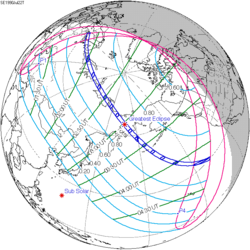| Annular eclipse | |
| Gamma | 0.8413 |
|---|---|
| Magnitude | 0.9767 |
| Maximum eclipse | |
| Duration | 113 s (1 min 53 s) |
| Coordinates | 56°12′N130°18′E / 56.2°N 130.3°E |
| Max. width of band | 153 km (95 mi) |
| Times (UTC) | |
| Greatest eclipse | 1:35:23 |
| References | |
| Saros | 118 (62 of 72) |
| Catalog # (SE5000) | 9288 |
An annular solar eclipse occurred at the Moon's descending node of orbit between Saturday, March 28 and Sunday, March 29, 1903, [1] [2] [3] with a magnitude of 0.9767. A solar eclipse occurs when the Moon passes between Earth and the Sun, thereby totally or partly obscuring the image of the Sun for a viewer on Earth. An annular solar eclipse occurs when the Moon's apparent diameter is smaller than the Sun's, blocking most of the Sun's light and causing the Sun to look like an annulus (ring). An annular eclipse appears as a partial eclipse over a region of the Earth thousands of kilometres wide. The Moon's apparent diameter was near the average diameter because it occurred 6.7 days after apogee (on March 22, 1903, at 8:40 UTC) and 7.8 days before perigee (on April 5, 1903, at 18:40 UTC). [4]
Contents
- Eclipse details
- Eclipse season
- Related eclipses
- Eclipses in 1903
- Metonic
- Tzolkinex
- Half-Saros
- Tritos
- Solar Saros 118
- Inex
- Triad
- Solar eclipses of 1902–1906
- Saros 118
- Metonic series
- Tritos series
- Inex series
- Notes
- References
Annularity was visible from China (now northwestern China, Mongolia and northeastern China), Russia on March 29 (Sunday), and Northern Canada on March 28 (Saturday). A partial eclipse was visible for parts of Southeast Asia, East Asia, North Asia, Alaska, and Northwestern North America.

































































































